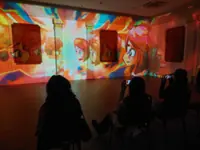Celebrated Malaysian painter Syed Thajudeen (left) chats with a visitor at BNM MAG’s newly-opened Asean-inspired 'Palette And Pen' exhibition, which pairs poetry with visual art, music, film, and literary-inspired illustrations. Photo: Bernama
As Malaysia leads the Asean Chair for 2025, arts and culture dialogue also takes prominence, with exhibitions and performances celebrating regional ties.
Here are four Asean-related exhibitions, currently showing in Kuala Lumpur, to explore:





